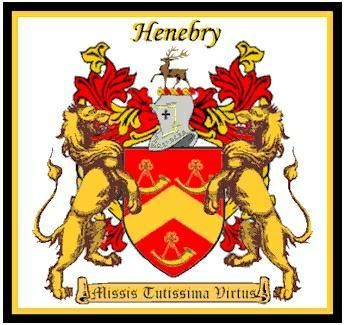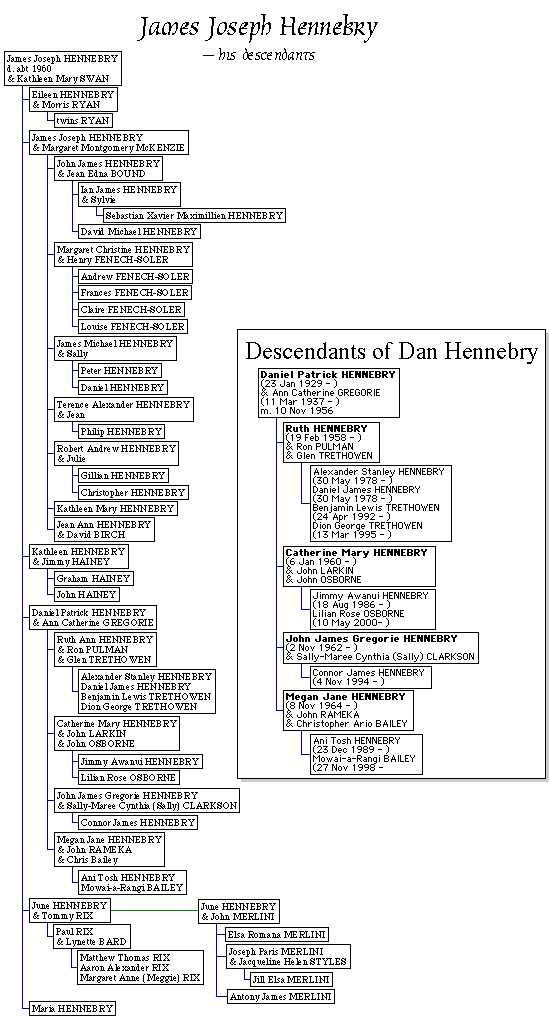
| Crest: | The stag represents peace and harmony. |
| Arms: | A red shield with a gold chevron and three gold bugle horns. Bugle horns representing strength and fortitude, chevron is protection, red is military fortitude and gold is generosity. |
| Motto: | "Missis tutissima virtus" |
| "Giving is the greatest virtue" |
© Henebry Clan 2001. All rights reserved.
Irish Counties of Limerick, Waterford, Cork and Tipperary.

The spelling of the surname Hennebry has changed over the years. Landowner records in Ireland have different spellings of the surname, eg Griffith’s Valuation of Ireland, 1848-1864 lists Henebrys, Heneberys, Hennebrys and Heneberrys.
There is no consensus on the origin of the surname Hennebry. Some accounts indicate the family came from Germany to Ireland.
Irish Roots magazine indicates an emigration of Palatine Germans to Limerick/Tipperary about 1709. There is a village in the Palatinate called Henneberg. Henry Hennebery and his wife Mariah, both from Germany, were living in Franklin County, MO, in the United States, according to the 1850 census.
The Vikings began their attacks on Ireland in 795. During the 9th century, they established strongholds around Ireland and founded Dublin, Limerick and other towns and villages. They were often called Danes by the Irish, but the majority were Norwegian.
The Gaelic term for the Danes was "Dubh-gall" or dark foreigner, and the term for the Norwegians was "Finn-gall" or fair foreigner. (eg. Galbally: bally = town and Gall = foreigner = Foreigners’s Town.) The Vikings settled in Ireland, married into Irish families and adopted the Gaelic language and culture and the Christian religion.
These Gaelic-Vikings fought their distant relatives a few hundred years later during the Norman invasion of Ireland, which started in 1169. Over the next hundred years, the Normans took control of three quarters of the land of Ireland.
The majority of Irish towns were established by Normans who spoke Norman-French. The province of Munster became one of the most prominent Norman settlements outside France.
The surname de Hindeberg or de Hynteberge would seem to have roots from the Viking-Norman-Frank surnames. This name appears in Ireland by 1250 as Henebry/Henneberry.
Other serious research has suggested that Henneberry has an Anglo-Saxon origin.
The Somerset surnames Hembra, Hembrow, Hembry, Hembury and Hennebry may derive from Hemborough (Devon), Broadhembury (Somerset), two places called Henbury (Cheshire and Bristol), all from derived from burh (fort) or beorh (hill). (Hanks, Patrick and Flavia Hodges, A Dictionary of Surnames, Oxford University Press, 1988, page 85.)
In later years, the suffix "-bury" was sometimes attached to a manor house, and a surname derived from it could be adopted by someone who lived near a manor house or was employed on the manor.
The first Hennebery in Ireland is claimed to be Lord Philip Hennebery, an English landowner. He had a castle and land in County Meath outside of Dublin in the 13th century.
Philip de Hynteberge (de Hindeberg) was lord of the manor of Rath, County Dublin, in 1250. He was part of the Norman military aristocracy which then controlled Ireland. The family, later called Henebry/Hanebry/Henneberry/Hennebry, migrated to Counties Kilkenny and Waterford. They are chiefly found in the latter county today, though the name is not common.
Father Richard Henebry (1863-1916) was a noted Gaelic scholar and collector of Irish music.